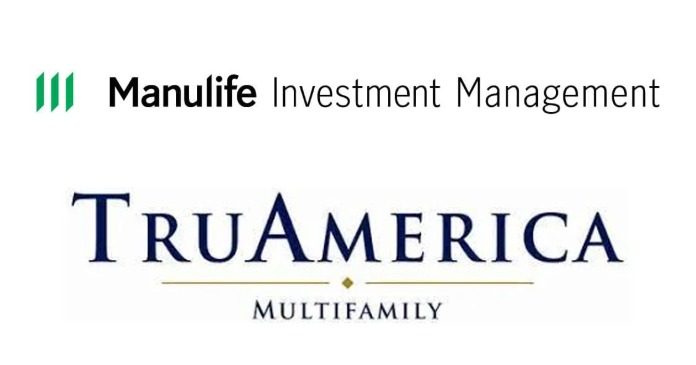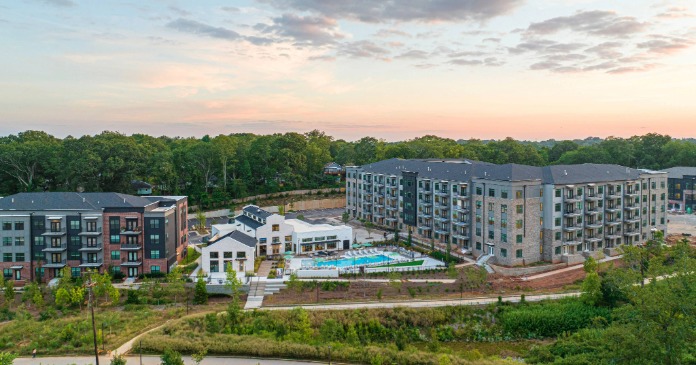
There’s an unexpected piece of paper taped to the glass entrance of 550 Vanderbilt, a luxury, high-rise in the Prospect Heights neighborhood of Brooklyn, N.Y.
Visitors might see it as they enter Ciao Gloria, the building’s specialty coffee shop. Potential residents visiting the building couldn’t miss it.
“Building Energy Efficiency Rating” said the sign. “D.”
New York City now requires all large residential buildings to “benchmark” by tracking the energy they use, producing a score that shows if the property is an efficient or inefficient user of energy. The property must also publicly post the resulting letter grade. If the shame is not enough to goad owners to improve inefficient buildings, New York City will soon begin to fine them—and the fines will get bigger as time goes on.
New York City now has the toughest benchmarking law in the U.S. But the Big Apple has a lot of competition.
About 40 cities and towns now require property owners to track the total energy used at larger buildings. Several of the biggest— like New York City and Washington, D.C.— recently toughened their rules to require investors who own inefficient apartment buildings to eventually pay to improve them.
Apartment investors are taking notice. These benchmarking requirements—and the scores they produce—have not yet had a tangible effect on the prices investors are willing to pay for apartment properties. But industry advocates worry that mandatory requirements may place another burden on new development.
“Every new regulation on development increases cost—which ultimately reduces housing supply and makes apartments less affordable,” said Ben Harrold, manager of public policy for the National Apartment Association, based in Arlington, Va.
Benchmarking rules spread
The number of cities and states that require property owners to benchmark grew rapidly in the years just before the coronavirus pandemic froze the U.S. economy in 2020. As the pandemic has seemed to wane, the number to jurisdictions that require benchmarking has begun to grow again.
In its simplest form, a property owner could benchmark the energy use at a property using just an Excel spreadsheet and a stack of utility bills. Benchmarking means quite simply that owners measure the amount of power or water used at these properties and compare that amount against some benchmark—usually either the amount used in the past at the same building or in comparable apartment buildings nearby.
“During coronavirus, unless it was critical, the cities weren’t asking for a lot of compliance material,” said Arthur Blankenship, president of Argen Billing & Conservation, based in Conyers, Ga. His firm helps property owners comply with requirements like benchmarking across the U.S.—but he had relatively few new customers during the pandemic as few new requirements were created. “Benchmarking went from being on the backburner to being off the stove.”
But as the pandemic finally wanes, more towns are likely to create new benchmarking standards or toughen old ones. “Other cities are going to start putting benchmarking standards in place,” said Blankenship. “It’s really just a matter of time.”
In September 2021, benchmarking became the law in the State of Colorado for any multifamily building with more than 50,000 square feet of space.
The owners of these buildings now have to enter their energy use into Energy Star Portfolio Manager, a free energy management tool used to track and assess energy and water consumption, created by the federal Department of Energy. The system gives each building a score that rates its energy efficiency on a scale of 1 to 100, with 50 representing the national median.
At apartment communities where the residents pay for their own energy, local utility companies must provide the data on how much electricity residents are using. In places like Colorado, where benchmarking is now required, many power companies can upload the data right into the benchmarking system.
Colorado joined the State of California, which passed its own benchmarking law back in 2015 that requires apartment buildings with more than 50,000 square feet of space to benchmark their energy use. Another 10 states require all buildings owned or leased by the state to benchmark their energy use.
In addition, about 40 cities and towns require owners to benchmark the utility use at their properties once a year.
“A good chunk of those cities require that information to be reported publicly,” say Zach Shelin, product manager for Measurabl, a technology company headquartered in New York City.
Of those cities and towns, roughly a dozen ask property owners to verify the energy information they submit with some kind of third-party commissioning process or an energy audit.
Only a handful of all of those jurisdictions ask property owners to take action to improve inefficient buildings—but more cities may toughen their rules as time passes.
Washington, D.C., passed its Green Building Act in 2006. Developers had to design any new building with more than 50,000 sq. ft. of space or major renovation to earn an Energy Star Score of 75, and benchmark the energy used in the building once the work is finished.
In 2018, D.C. began to tighten the screws with its Clean Energy D.C. Omnibus Act. Starting in 2021, all buildings over 50,000 that don’t meet a certain standard for energy use enter “a compliance cycle.” Smaller buildings will get swept into the program as the years pass.
Chicago passed its Energy Benchmarking Ordinance in 2013, requiring residential buildings with more than 50,000 sq. ft. of space to benchmark. In 2017, Chicago began to rate these buildings, giving each building one to five stars, based on their Energy Star scores. Building owners have to post a card with their energy rating “on their building in a location visible to the public and visitors,” said the Chicago law.
NYC toughest benchmarking rules
The Big Apple started early, requiring benchmarking since 2009.
In 2018, New York City began to assign each benchmarked building a letter grade based on its Energy Star score. The City’s buildings scored slightly better than the national average, with a median of about 60, according to Steven Winter Associates. A score of 55 or less earned a building a “D.”
In 2020, over half of NYC buildings have received C or D grades. Building owners have to post their grade by a public entrance.
The next year, in 2019, the rules got even tougher. Starting in 2024, apartment buildings in NYC would have to meet limits for how much energy they used that get tougher as the years pass—large and medium-sized buildings must reduce the carbon emissions caused by their utility use by 40 percent by 2030. Inefficient buildings would eventually be threated with fines.
Investors barely talk about benchmarking over the last few years because of the chaos of the coronavirus pandemic, which killed thousands in the City. Many New Yorkers fled during the first months of the lockdown. The percentage of apartments that were vacant rose several percentage points. Many apartment towers that opened during that pandemic offered three and even four months of free rent as they struggled to rent their new apartments.
Investors also largely stopped buying until very recently. Manhattan fell to become the 24th largest market for sales of apartment properties in 2021, down from the ninth largest in 2019, according to Real Capital Analytics, based in New York City.
Nearly two years later, New York City’s apartment markets have fully recovered, though the pandemic is still not yet over. In Manhattan, the percentage of occupied apartments and asking rents were both higher in September 2022 than they had been in the fourth quarter of 2019, before the pandemic, according to CoStar Group. Asking rents had risen nearly 10 percent above their pandemic lows for Manhattan’s luxury apartments (rated with four or five stars in CoStar’s five-star system), and were likely to keep rising into 2023.
As apartment investors rush back to New York City, the strict benchmarking rules created in the year before the pandemic are suddenly becoming important.
“In just the last two months people have been talking about it more than ever,” said Rob Hinckley, senior managing director in the New York office of JLL Capital Markets, Americas. “Six months ago there wasn’t much of a transaction market up until now most people had their eyes closed.”
Before the pandemic, the first threatened enforcement of fines on inefficient buildings seemed far in the future, starting at small amounts. “It was so many years out,” said Hinckley.
Even now, as apartment properties trade again, NYC’s Energy Grades are not changing the capitalization rates that investors are willing to accept when they buy an apartment building in New York. That’s because efficient buildings are already rewarded with higher prices because they are already saving money on their operating expenses.
“We sold a couple of buildings rated “A” and “B” in the last couple of months,” said Hinckley. “The energy efficiency of the property was already embedded in the cost.”
The benchmarking requirements do not seem to be frightening investors away either— even from buildings with terrible NYC Energy Grades. These low-scores may even be attractive to more opportunistic investors planning to add value to properties they buy. The inefficiency of these buildings is probably also already reflected in their low operating income and corresponding low sale price. But the low grade may also represent room for improvement—and an opportunity for a new buyer to renovate the building to become more profitable.
“If your building is a 35 on the Energy Star scale, there are going to some easy opportunities on the operations side,” said Measurabl’s Shelin.
Core real estate investors, on the other hand, are likely to be drawn to efficient buildings with high scores. “A good Energy Star score is a proxy for strong management in a building,” said Hinckley.
Some apartment experts worry the requirements will eventually hurt older apartments.
“Benchmarking and reporting policies can disadvantage older buildings because they will be forced to disclose inefficiencies that are difficult to fix,” said NAA’s Harrold. “Older buildings often have a particularly difficult time meeting energy standard requirements. Past technology and construction practices were less energy efficient.”
Apartment developers may also struggle to pay the extra cost of extra insulation and efficient HVAC systems that might be needed to earn a strong Energy Star score when a building is benchmarked.
“Developing housing remains difficult and costly process in most jurisdictions,” said Harrold. “Every new regulation on development increases cost, which ultimately reduces the housing supply and makes apartments less affordable.”
So far, however, developers are still rushing to build in New York City and the other top apartment markets that now require benchmarking like Los Angeles, Chicago, Seattle and Washington, D.C. Benchmarking requirements have not slowed developers down in these cities.
“Other policy issues like rent control laws are the big factors [worries] we more often hear about,” said Jay Parsons, deputy chief economist for RealPage.
Developers is New York City may even benefit from the City’s tough benchmarking rules. Some institutional investors have become interested in developments in New York City because they are looking for investments that meet their new environment, social, governance (ESG) criteria.
JLL is now helping a developer gather the financing to build a new apartment tower in Downtown Brooklyn. The new apartments will have to be sustainably designed and benchmark its utility use to comply with all of New York City’s rules. Those green features help the project attract a joint venture partner that now plans to contribute enough equity to the project to cover 20 percent of its development cost. The partner is an insurance fund that favors investments that meet “Environmental Social Governance” standards.
“You get more capital sources interested in developments that meet ESG standards,” said Hinckley.
Benchmarking , energy efficiency pay
Even when apartment owners are challenged to cut their energy use and track the results by benchmarking, the needed renovations can quickly pay for themselves.
A group of 13 leading affordable housing developers proved that when they committed to benchmark and cut the energy and water used by 20 percent between 2013 and 2020 at the thousands of apartments they managed.
“It does pay for itself,” said Katherine Fleming, senior vice president of portfolio from Bridge Housing, based in San Francisco.
Bridge and the other 13 members of Stewards of Affordable Housing for the Future (SAHF) exceeded in their “Big Reach” commitment. They cut their energy use by 29 percent and their water by 24 percent.
For example, utility rebates and incentives provided about $1,000 per unit for discretionary retrofits at more than 20,000 homes in 236 properties owned by the SAHF members. The renovations have created annual savings of more than $150 per unit per year, according to SAHF—a payback of less than seven years.
Benchmarking did not just help SAHF verify the results of their work. “It helps us evaluate and identify properties where efficiency upgrades can have the biggest impact,” said Fleming.
Author Bendix Anderson














